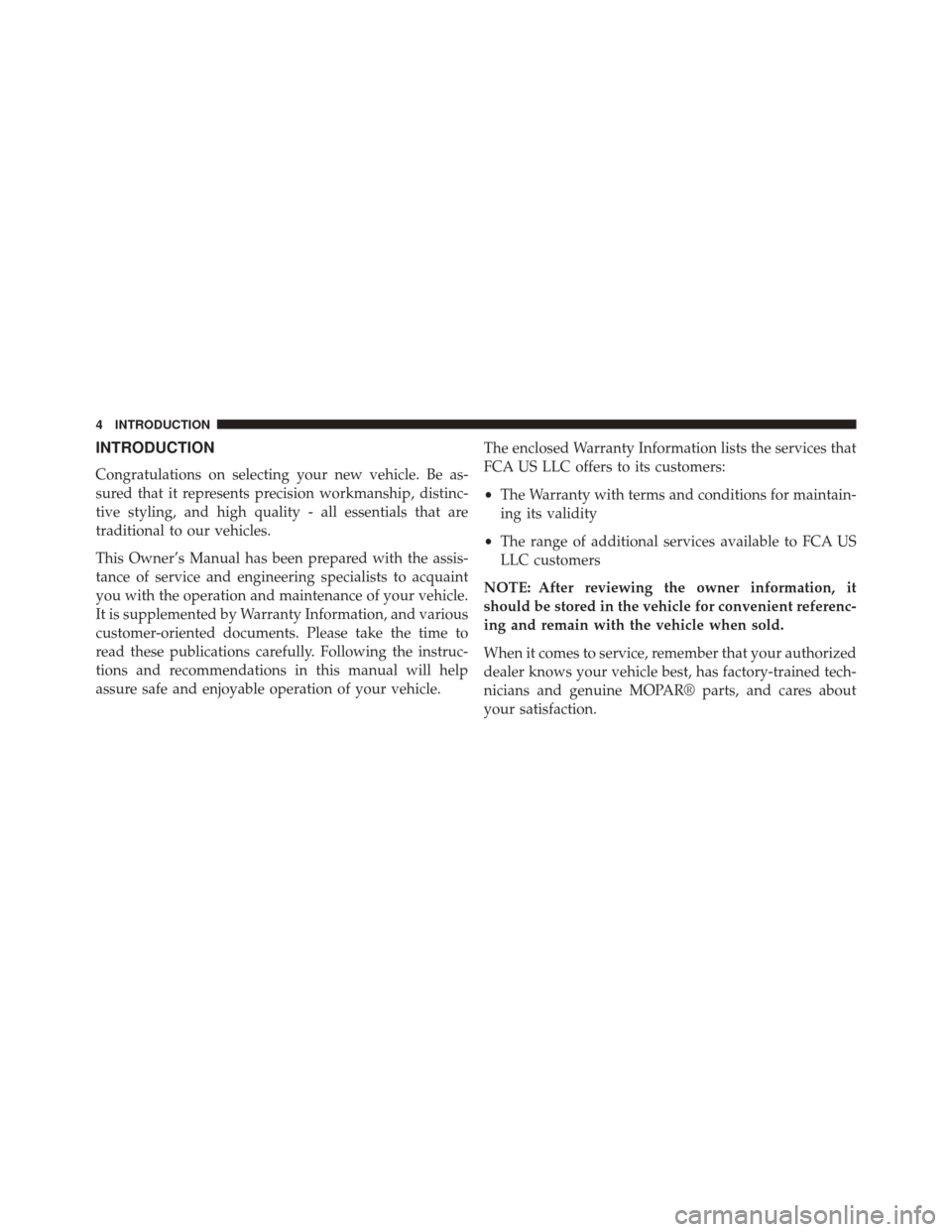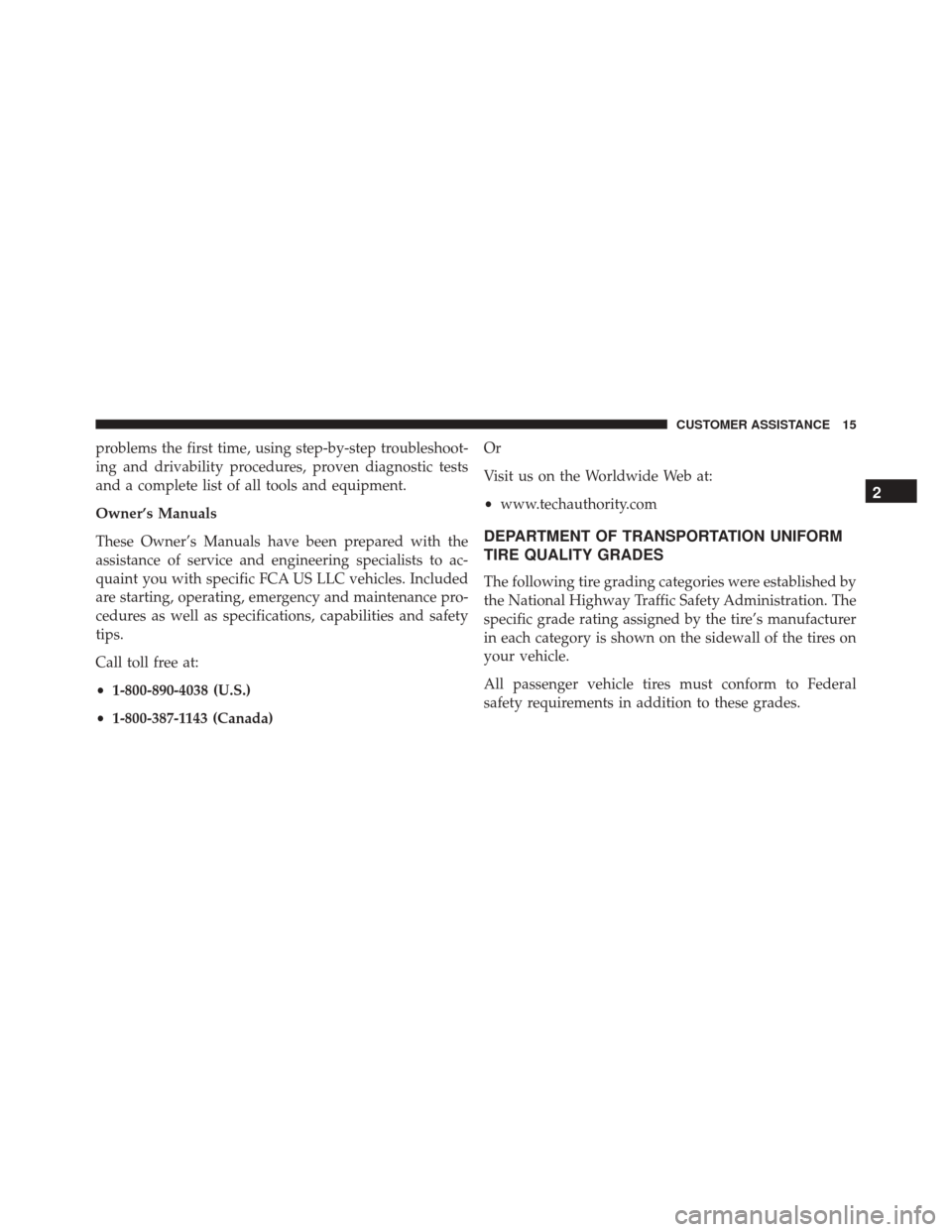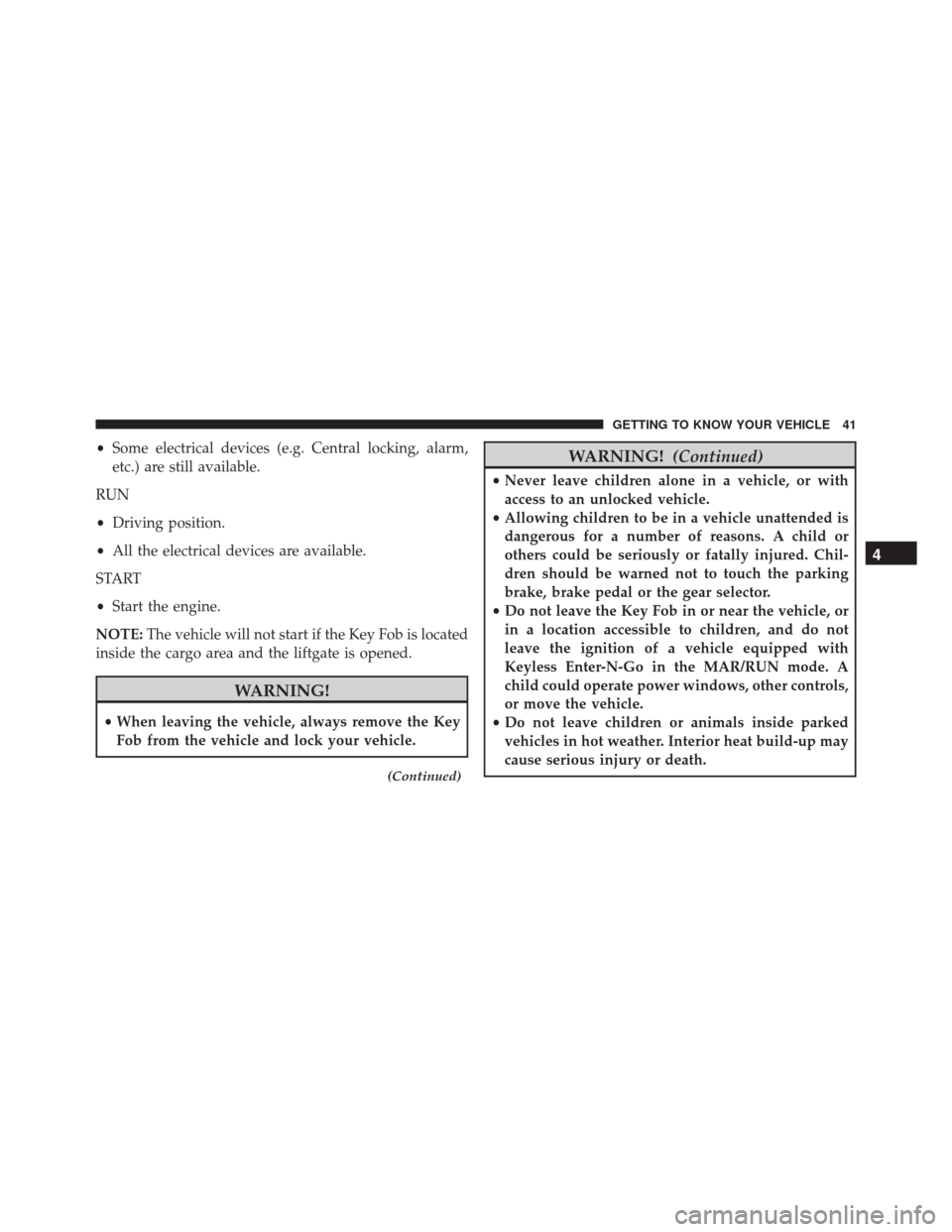Page 6 of 587

INTRODUCTION
Congratulations on selecting your new vehicle. Be as-
sured that it represents precision workmanship, distinc-
tive styling, and high quality - all essentials that are
traditional to our vehicles.
This Owner’s Manual has been prepared with the assis-
tance of service and engineering specialists to acquaint
you with the operation and maintenance of your vehicle.
It is supplemented by Warranty Information, and various
customer-oriented documents. Please take the time to
read these publications carefully. Following the instruc-
tions and recommendations in this manual will help
assure safe and enjoyable operation of your vehicle.The enclosed Warranty Information lists the services that
FCA US LLC offers to its customers:
•
The Warranty with terms and conditions for maintain-
ing its validity
• The range of additional services available to FCA US
LLC customers
NOTE: After reviewing the owner information, it
should be stored in the vehicle for convenient referenc-
ing and remain with the vehicle when sold.
When it comes to service, remember that your authorized
dealer knows your vehicle best, has factory-trained tech-
nicians and genuine MOPAR® parts, and cares about
your satisfaction.
4 INTRODUCTION
Page 15 of 587

sincere efforts to resolve any warranty issues or related
concerns.
WARNING!
Engine exhaust (internal combustion engines only),
some of its constituents, and certain vehicle compo-
nents contain, or emit, chemicals known to the State
of California to cause cancer and birth defects, or
other reproductive harm. In addition, certain fluids
contained in vehicles and certain products of compo-
nent wear contain, or emit, chemicals known to the
State of California to cause cancer and birth defects,
or other reproductive harm.
WARRANTY INFORMATION
See the Warranty Information Booklet, located on the
DVD, for the terms and provisions of FCA US LLC
warranties applicable to this vehicle and market.
REPORTING SAFETY DEFECTS
In The 50 United States And Washington, D.C.
If you believe that your vehicle has a defect that could
cause a crash or cause injury or death, you should
immediately inform the National Highway Traffic Safety
Administration (NHTSA) in addition to notifying the
manufacturer.
If NHTSA receives similar complaints, it may open an
investigation, and if it finds that a safety defect exists in
a group of vehicles, it may order a recall and remedy
campaign. However, NHTSA cannot become involved in
individual problems between you, your authorized
dealer, and the manufacturer.
To contact NHTSA, you may either call the Auto Safety
Hotline toll free at 1-888-327-4236 (TTY: 1-800-424-9153),
or go to http://www.safercar.gov; or write to: Adminis-
trator, NHTSA, 1200 New Jersey Avenue, SE., West
Building, Washington, D.C. 20590.2
CUSTOMER ASSISTANCE 13
Page 17 of 587

problems the first time, using step-by-step troubleshoot-
ing and drivability procedures, proven diagnostic tests
and a complete list of all tools and equipment.
Owner’s Manuals
These Owner’s Manuals have been prepared with the
assistance of service and engineering specialists to ac-
quaint you with specific FCA US LLC vehicles. Included
are starting, operating, emergency and maintenance pro-
cedures as well as specifications, capabilities and safety
tips.
Call toll free at:
•1-800-890-4038 (U.S.)
• 1-800-387-1143 (Canada) Or
Visit us on the Worldwide Web at:
•
www.techauthority.com
DEPARTMENT OF TRANSPORTATION UNIFORM
TIRE QUALITY GRADES
The following tire grading categories were established by
the National Highway Traffic Safety Administration. The
specific grade rating assigned by the tire’s manufacturer
in each category is shown on the sidewall of the tires on
your vehicle.
All passenger vehicle tires must conform to Federal
safety requirements in addition to these grades.
2
CUSTOMER ASSISTANCE 15
Page 22 of 587
FRONT VIEW
Front View
1 — Engine Compartment
2 — Headlights
3 — Windshield4 — Outside Mirrors
5 — Doors
6 — Wheels
20 GRAPHICAL TABLE OF CONTENTS
Page 40 of 587
NOTE:When having the Sentry Key Immobilizer System
serviced, bring all vehicle keys with you to an authorized
dealer.
IGNITION SWITCH
Operation
Your vehicle uses either a key start ignition system or
keyless ignition system. The key start ignition system
consists of a Key Fob with a Remote Keyless Entry (RKE)
transmitter and an Integrated Mechanical Key Ignition.
The keyless ignition system consists of a Key Fob with
Remote Keyless Entry (RKE) transmitter and a Keyless
Push Button Ignition.
Mechanical Key
The Mechanical Key has three operating positions, two
with detents and one that is spring-loaded. The detent
positions are STOP/OFF, MAR/RUN, and AVV/START.
The AVV/START position is a spring-loaded momentary contact position. When released from the AVV/START
position, the switch automatically returns to the MAR/
RUN position.
1 — STOP/OFF
•
The engine is stopped.Integrated Mechanical Key Ignition
38 GETTING TO KNOW YOUR VEHICLE
Page 41 of 587
•The key can be removed from the ignition.
• The steering column can be locked (with the ignition
key removed).
• Some electrical devices (e.g. power locks, alarm, etc.)
are still available.
2 — MAR/RUN
• Driving position.
• Electrical devices are available.
3 — AVV/START
• Start the engine.
The ignition switch is provided with a safety mechanism.
If the engine fails to start, the ignition will return to the
STOP/OFF position prior to repeating the starting pro-
cedure. On models equipped with an automatic transmission, the
ignition key is only removable when the shift lever is in
PARK.
Electronic Key
This Keyless Enter-N-Go system feature allows the driver
to operate the ignition switch with the push of a button as
long as the Remote Keyless Entry (RKE) transmitter is in
the passenger compartment.
The Keyless Push Button Ignition has three operating
positions. The three positions are STOP, RUN, and
START.4
GETTING TO KNOW YOUR VEHICLE 39
Page 42 of 587
NOTE:If the ignition switch does not change with the
push of a button, the RKE transmitter (Key Fob) may
have a low or dead battery. In this situation, a back up
method can be used to operate the ignition switch. Put
the nose side (side opposite of the emergency key) of the
Key Fob against the ENGINE START/STOP button and
push to operate the ignition switch.
The Keyless Push Button Ignition can be placed in the
following positions:
STOP
•The engine is stopped.
Engine Start Stop Button
40 GETTING TO KNOW YOUR VEHICLE
Page 43 of 587

•Some electrical devices (e.g. Central locking, alarm,
etc.) are still available.
RUN
• Driving position.
• All the electrical devices are available.
START
• Start the engine.
NOTE: The vehicle will not start if the Key Fob is located
inside the cargo area and the liftgate is opened.
WARNING!
• When leaving the vehicle, always remove the Key
Fob from the vehicle and lock your vehicle.
(Continued)
WARNING! (Continued)
•Never leave children alone in a vehicle, or with
access to an unlocked vehicle.
• Allowing children to be in a vehicle unattended is
dangerous for a number of reasons. A child or
others could be seriously or fatally injured. Chil-
dren should be warned not to touch the parking
brake, brake pedal or the gear selector.
• Do not leave the Key Fob in or near the vehicle, or
in a location accessible to children, and do not
leave the ignition of a vehicle equipped with
Keyless Enter-N-Go in the MAR/RUN mode. A
child could operate power windows, other controls,
or move the vehicle.
• Do not leave children or animals inside parked
vehicles in hot weather. Interior heat build-up may
cause serious injury or death.
4
GETTING TO KNOW YOUR VEHICLE 41